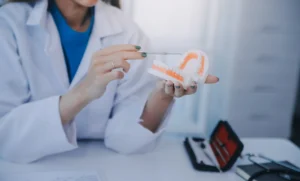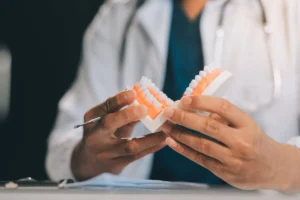Cosmetic dentistry has become increasingly popular over the years, as more people seek ways to improve their smiles and overall appearance.
But what exactly is cosmetic dentistry, and how does it work?
This article explores cosmetic dentistry in detail, including how it works, and the benefits it offers.
Key Takeaways:
- Cosmetic dentistry offers individuals an opportunity to align their external appearance with their self-image, providing psychological and functional benefits.
- Common types of cosmetic dentistry procedures include teeth whitening, dental crowns, inlays and overlays, and dental implant installations.
Table of Contents
Cosmetic Dentistry: What is it?
Cosmetic dentistry refers to dental work that improves the appearance of a person’s teeth, gums, or bite. The focus is primarily on enhancing dental aesthetics in color, position, shape, size, alignment, and overall smile appearance.
Unlike general dental care, which focuses on the health and functionality of your teeth, cosmetic dentistry is geared toward aesthetic improvement.
What is Considered Cosmetic Dentistry?
Here are some of the most common procedures that fall under the umbrella of what is considered cosmetic dentistry:
1. Teeth Whitening
One of the most accessible and widely used cosmetic dental procedures, teeth whitening, can dramatically enhance the brightness and whiteness of your teeth. Over time, teeth can become stained from foods, drinks, smoking, and certain medications. Teeth whitening is a quick, effective way to combat these effects
2. Dental Veneers
Veneers are thin shells made from porcelain or composite material, designed to cover the front surface of teeth. They are custom-made to fit the patient and can fix a wide variety of dental issues such as discolored teeth, chipped or broken teeth, and even gaps between teeth.
3. Dental Bonding
In this procedure, a dentist applies a tooth-colored resin to the tooth and hardens it with ultraviolet light. The material bonds to the tooth and can be shaped and polished to match the surrounding teeth. It’s often used for repairing decayed, chipped, cracked, or misshapen teeth.
4. Dental Crowns
Crowns, or caps, fit over and replace the entire decayed or damaged tooth above the gum line, restoring its shape, size, strength, and appearance. Crowns prevent tooth breakage or hold a cracked tooth together; they can be made from metals, porcelain, or ceramic.
5. Inlays and Onlays
Also known as indirect fillings, inlays and onlays are made from porcelain or composite materials and provide a “filling” to teeth with tooth decay or similar structural damage. Unlike dental fillings that are molded into place within the mouth during a dental visit, inlays and onlays are created in a dental laboratory before being fitted and adhesively bonded into place by your dentist.
6. Dental Implants
Implants are used to replace lost teeth. The process involves inserting a titanium implant into the jawbone at the site of the missing tooth, which serves as a support for a crown. These are considered cosmetic because they restore and enhance the look of one’s smile.
How Does Cosmetic Dentistry Work?
The process typically begins with a consultation, where a dental professional assesses the patient’s oral health and discusses the aesthetic goals. Next, they craft a treatment plan that is tailored to the specific needs and desires of the patient.
Here are some common steps in the process:
- Assessment and Planning — Detailed imaging and possibly dental impressions will be taken to guide the design of the treatment.
- Preparation — Teeth might be prepped for procedures like veneers or crowns, involving some reshaping of the existing teeth.
- Procedure — Depending on the treatment, various procedures may be performed in one or more visits.
- Follow-up — Additional visits may be needed to check the results and make minor adjustments.
Benefits of Cosmetic Dentistry
The benefits of cosmetic dentistry extend beyond just improving the aesthetic appearance of the teeth. It can also provide a significant boost in self-esteem and confidence.
Improved dental aesthetics can enhance social interactions, professional opportunities, and overall quality of life. Additionally, some procedures can help preserve the natural tooth structure and improve oral health.
Contact Dixon Dental for Quality Cosmetic Dentistry
For cosmetic dentistry services that can transform your smile and improve the quality of your life, contact Dixon Dental Center. Our dentists have decades of experience in performing successful dentist procedures. Contact us today to schedule a consultation.



